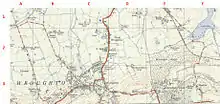Burderop Park
Burderop Park is a Grade II* listed country manor house, situated near Chiseldon, Wiltshire.[1] The house was constructed in the early 17th century to a courtyard design and later turned into a three-storey square house with bay windows during the 18th century. The house is the manor to the local hamlet of Hodson to the east of the house. The north of the estate is Burderop Wood, which was designated a 'Biological Site of Special Scientific Interest' in 1971 due to the wet Ash-maple and acid Pedunculate oak-Hazel-Ash woodland.[2]
| Burderop Park | |
|---|---|
 Burderop House in 2008 | |
 Location within Wiltshire | |
| General information | |
| Town or city | Hodson, Wiltshire |
| Country | England |
| Coordinates | 51.519886°N 1.761192°W |
| Construction started | Early 17th Century |
| Completed | 18th Century |
| Client | William Calley |
| Technical details | |
| Structural system | Brick |
History

The Calley family lived at Burderop for over two centuries; in 1649 William Calley was High Sheriff of Wiltshire and in 1807 Thomas Calley also held the title. Thomas was married to Elizabeth Keck, daughter of Anthony James Keck of Stoughton Grange; they had a son John James Calley, who sold the estate to John Parkinson, who held the estate as a trustee, for the Duke of Wellington. The estates of Broad Hinton and Salthrop House were also owned by Thomas Calley and his wife and were sold in 1860 by the second Duke of Wellington to Anthony M. S. Maskelyne of Bassets Down.[3] The estate was for a time known as Okebourne Chace.[4]
World Wars
During World War I and World War II the estate was used as a training camp for the British army and was also the first military camp in Britain to receive American soldiers, who ran the 7505th USA Field Hospital that was stationed at Burderop Park. The Camp had its own railway station and recreational facilities which even hosted Bob Hope.[5] The 1959 Ordnance Survey map shows Burderop Park still with huts from the war (cell E3).
Post-war

Today the house is part of a complex of buildings used for commercialised agricultural landholding and office space for CH2M, and previously for the Halcrow Group.[4]
Interior
The house has oak panelling and plaster ceilings dating from the 17th century, with 18th-century marble fireplaces. There is a painted coat of arms of William Calley dated 1663 over the original fireplace in a first-floor bedroom. Two other rooms have 17th-century paint work on the walls, including a Jacobean-style panelling design. Part of a newel stair survives in centre of north wing, which is thought to be a former stair-turret.[6]
References
| Wikimedia Commons has media related to Burderop Park. |
- Historic England. "Burderop Park (Grade II*) (1023307)". National Heritage List for England. Retrieved 31 July 2015.
- http://www.english-nature.org.uk/citation/citation_photo/1002413.pdf
- Ball, M (2007) "Broad Hinton", http://www.oodwooc.co.uk/ph_brhint_a.htm
- "Jefferies' Land: Burderop Park". Swindon Advertiser. 9 March 2011. Retrieved 31 July 2015.
- Swindonweb (2008) "Chiseldon Camp", http://www.swindonweb.com/index.asp?m=8&s=116&ss=763
- British Listed Buildings (2010) "Burderop Park, Chiseldon", http://www.britishlistedbuildings.co.uk/en-318277-burderop-park-chiseldon
